
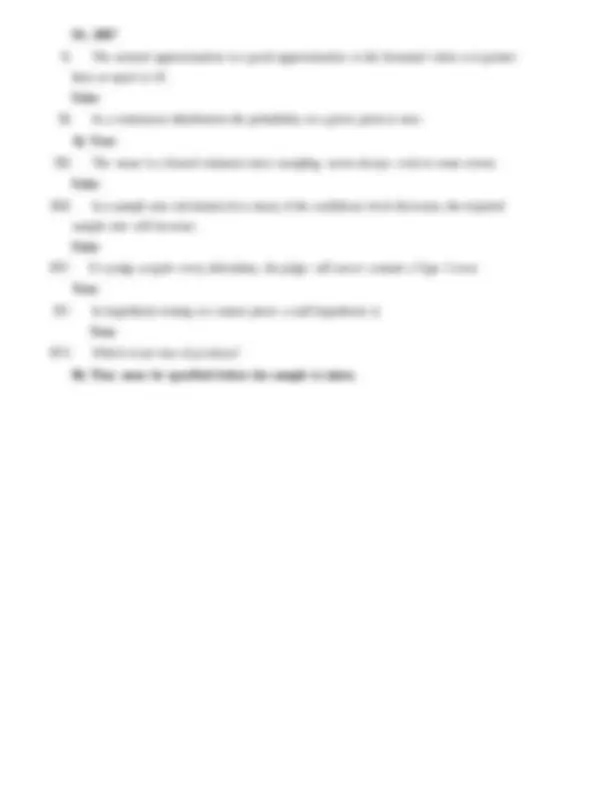
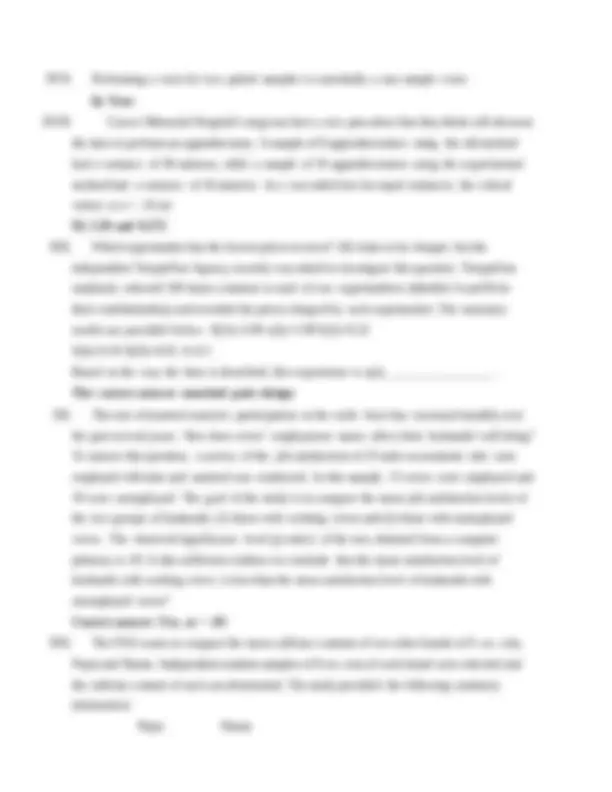
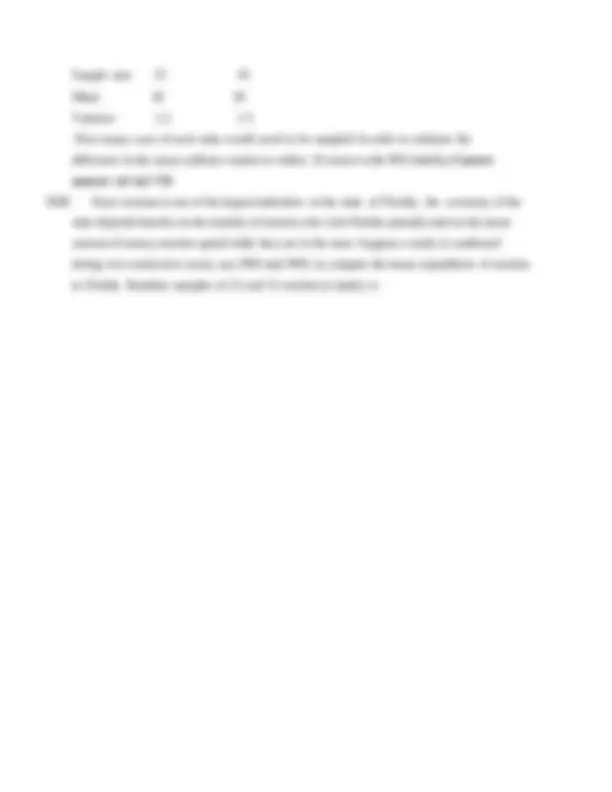
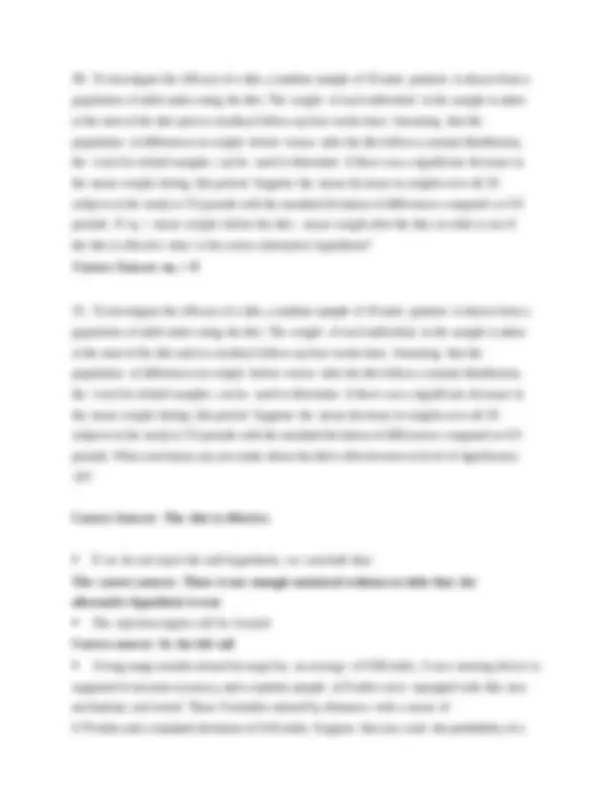
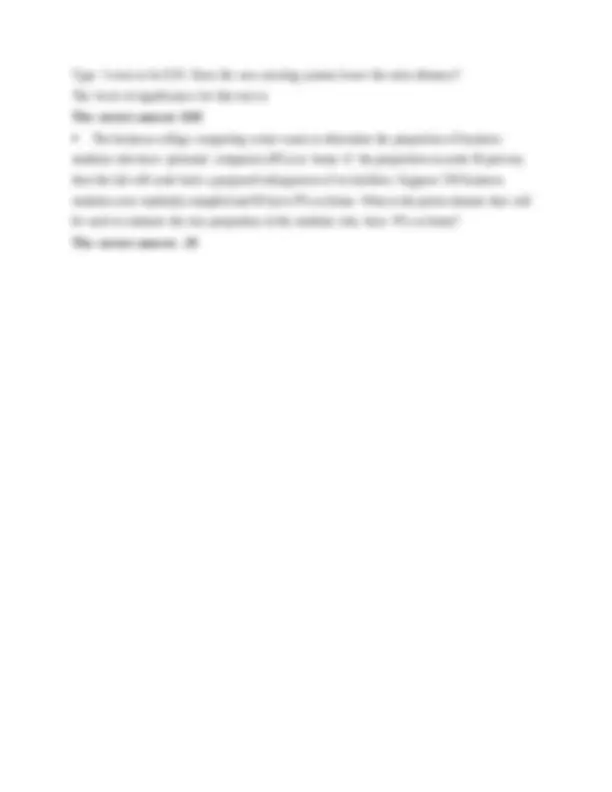



Study with the several resources on Docsity

Earn points by helping other students or get them with a premium plan


Prepare for your exams
Study with the several resources on Docsity

Earn points to download
Earn points by helping other students or get them with a premium plan
Community
Ask the community for help and clear up your study doubts
Discover the best universities in your country according to Docsity users
Free resources
Download our free guides on studying techniques, anxiety management strategies, and thesis advice from Docsity tutors
Various questions and answers related to statistical hypothesis testing, including tests for population proportions, type i errors, sampling techniques, confidence intervals, and estimators. It also covers properties of the arithmetic mean, sampling distribution of the mean, normal probability plots, and t-tests for two paired samples. Examples are provided for hypothesis testing, confidence intervals, and t-tests.
Typology: Exams
1 / 11

This page cannot be seen from the preview
Don't miss anything!







QN 1:The confidence interval and the two-sided hypothesis test are not equivalent for which of the following testing cases. Correct Answer: Test for a population proportion
true value of p is not .7, then we have made a___________________. The correct answer: Type I error
Correct answer : quota
Correct Answer: The Z value is also called the critical value.
Correct Answer: H0 refers to a specified value of a sample statistic.
even more extreme than the value observed, given that the null hypothesis is true, is referred to as what? Correct Answer: The p-value.
draw? Correct Answer: The null hypothesis should not be rejected.
Correct Answer: The null hypothesis should be rejected.
Correct Answer: It is found in the tail that supports the alternative hypothesis.
hypothesized population parameter? Correct Answer: The test statistic.
Correct Answer: The confidence coefficient.
Your Answer: If the null hypothesis is true, we reject it 1% of the time.
what assumption? Correct Answer: It assumes all of the above.
variance of the differences is unknown, how many degrees of freedom exist? Correct Answer: n - 1.
null hypothesis? Correct Answer: The population mean difference is equal to 0. I. Consider the following random sample from a normal population: 10, 5, 9, 12, 7, and 5. What is the 95% confidence interval for the population variance? Correct Answer: (3.12, 48.13) II. 25.1 yards plus or minus 4.1 yards III. Estimators are evaluated on all of the following properties EXCEPT Correct Answer: effectiveness IV. The sample mean is an unbiased point estimator of Correct Answer: the population mean. V. Which of the following is not a property of the arithmetic mean? Correct Answer: It is always equal to the population mean. VI. The sampling distribution of the mean is a distribution of Correct Answer: statistics. VII. A two-dimensional plot of the observed data values on the vertical-axis with their corresponding quantile values from a standardized normal distribution on the horizontal- axis is referred to as a Correct answer: normal probability plot. VIII. The length of brook trout caught in a certain Colorado stream has a mean of 14 inches and a standard deviation of 3 inches. The first quartile for the lengths of brook trout would be C) 11.98 inches. IX. Excel's =RAND() function produces random numbers that are uniformly distributed between 0 and 1. The standard deviation of this distribution is approximately
XVII. Performing a t-test for two paired samples is essentially a one sample t-test.
XVIII. Carver Memorial Hospital's surgeons have a new procedure that they think will decrease the time to perform an appendectomy. A sample of 8 appendectomies using the old method had a variance of 36 minutes, while a sample of 10 appendectomies using the experimental method had a variance of 16 minutes. In a two-tailed test for equal variances, the critical values at α = .10 are D) 3.29 and 0. XIX. Which supermarket has the lowest prices in town? All claim to be cheaper, but the independent TempteStat Agency recently was asked to investigate this question. TempteStat randomly selected 100 items common to each of two supermarkets (labelled A and B for their confidentiality) and recorded the prices charged by each supermarket. The summary results are provided below: X(A)=2.09 x(b)=1.99 S(A)=0. S(b)=0.19 S(D)=0.03 A=0. Based on the way the data is described, this experiment is a(n) __________________. The correct answer: matched pairs design XX. The rate of married women's participation in the work force has increased steadily over the past several years. How does wives' employment status affect their husbands' well being? To answer this question, a survey of the job satisfaction of 25 male accountants who were employed full-time and married was conducted. In this sample, 15 wives were employed and 10 were unemployed. The goal of the study is to compare the mean job satisfaction levels of the two groups of husbands: (1) those with working wives and (2) those with unemployed wives. The observed significance level (p-value) of the test, obtained from a computer printout, is .03. Is this sufficient evidence to conclude that the mean satisfaction level of husbands with working wives is less than the mean satisfaction level of husbands with unemployed wives? Correct answer: Yes, at =. XXI. The FDA wants to compare the mean caffeine contents of two other brands of 6 -oz. cola, Pepsi and Shasta. Independent random samples of 6-oz. cans of each brand were selected and the caffeine content of each can determined. The study provided the following summary information: Pepsi Shasta
Sample size 15 10 Mean 18 20 Variance 1.2 1. How many cans of each soda would need to be sampled in order to estimate the difference in the mean caffeine content to within .10 ounces with 90% liability Correct answer: n1=n2= XXII. Since tourism is one of the largest industries in the state of Florida, the economy of the state depends heavily on the number of tourists who visit Florida annually and on the mean amount of money tourists spend while they are in the state. Suppose a study is conducted during two consecutive years, say 1992 and 1993, to compare the mean expenditure of tourists in Florida. Random samples of 21 and 31 tourists (a family is
same test for females. The estimate of the difference in means is to be correct to with 5 points with a confidence coefficient of 0.95. If the sample sizes are to be equal, find. From past records, it is known that the range of test scores is 48. The correct answer: 45
normally distributed with equal variances. The first sample has a mean of 35.5 and standard deviation of 3.0 while the second sample has a mean of 33.0 and standard deviation of 4.0. Based on the data, the p-value for the F test of equal variances will be .166. Based on this p-value, is the assumption of equal variances correct? Correct Answer: The assumption is correct.
population of adult males using the diet. The weight of each individual in the sample is taken at the start of the diet and at a medical follow-up four weeks later. Assuming that the population of differences in weight before versus after the diet follow a normal distribution, the t-test for related samples can be used to determine if there was a significant decrease in the mean weight during this period. Suppose the mean decrease in weights over all 16 subjects in the study is 3.0 pounds with the standard deviation of differences computed as 6. pounds. If md = mean weight before the diet - mean weight after the diet, in order to see if the diet is effective what is the correct alternative hypothesis? Correct Answer: md > 0
population of adult males using the diet. The weight of each individual in the sample is taken at the start of the diet and at a medical follow-up four weeks later. Assuming that the population of differences in weight before versus after the diet follow a normal distribution, the t-test for related samples can be used to determine if there was a significant decrease in the mean weight during this period. Suppose the mean decrease in weights over all 16 subjects in the study is 3.0 pounds with the standard deviation of differences computed as 6. pounds. What conclusion can you make about the diet's effectiveness at level of significance .05? Correct Answer: The diet is effective.
The correct answer: There is not enough statistical evidence to infer that the alternative hypothesis is true
Correct answer: In the left tail
supposed to increase accuracy, and a random sample of 8 miles were equipped with this new mechanism and tested. These 8 missiles missed by distances with a mean of 0.76 miles and a standard deviation of 0.04 miles. Suppose that you want the probability of a
Correct Answer: The ratio of the two sample variances.
observations rather than the observations themselves? Correct Answer: A test for the mean difference between two related populations.
estimate of the population proportion can be used for two-tail tests where the null hypothesis assumes that the population proportions are equal. What is the alternative hypothesis? Correct Answer: H1: π1 not equal to π
Correct Answer: To test for equality of proportions.
from their corresponding expected frequencies? Correct Answer: The chi-square test.
degrees of freedom will the test statistic have? Correct Answer: 6
proportions? Correct Answer: A chi-square test for independence.
Correct Answer: The Marascuilo procedure.
that has r rows and c columns, how many degrees of freedom will the test statistic have? Correct Answer: (r - 1)(c - 1).